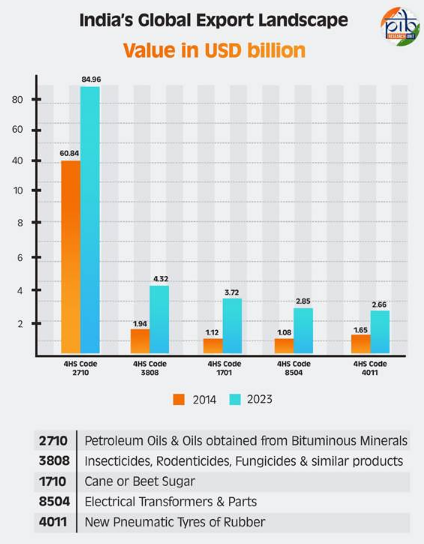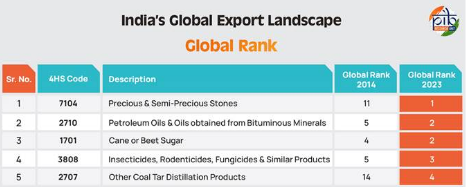
India’s journey toward global trade leadership is a narrative of growth, innovation, and strategic excellence. Over the years, the country has made significant progress across diverse export sectors, leveraging advanced manufacturing, technology, and robust policy support to meet global demands. By enhancing its export portfolio and reinforcing its reputation as a reliable supplier, India is steadily emerging as a formidable economic power.
India has cemented its position as the second-largest exporter of petroleum oils globally, with exports reaching $84.96 billion in 2023, reflecting a global market share of 12.59%. Advanced refining capabilities and adherence to international standards have driven this growth, ensuring India’s prominence in the energy sector.
Insecticides, rodenticides, and fungicides exports soared to $4.32 billion in 2023, capturing a 10.85% global market share. India’s R&D focus and compliance with global agricultural standards have made it the third-largest agrochemical exporter, aiding global sustainability.
India’s sugar exports surged to $3.72 billion in 2023, accounting for a 12.21% share in the global market. Strong agricultural policies and robust production have positioned India as the second-largest exporter globally.
India’s exports in electrical transformers and semiconductors have seen exponential growth. Semiconductor exports, for instance, rose from $0.23 billion in 2014 to $1.91 billion in 2023, signifying India’s growing role in global supply chains.
India dominates the global market for precious and semi-precious stones, holding an impressive 36.53% share in 2023. This growth reflects the blend of traditional craftsmanship and modern processing technologies.
Exports of rubber pneumatic tyres reached $2.66 billion in 2023, while industrial products like taps and valves earned $2.12 billion, showcasing India’s advanced manufacturing capabilities and cost competitiveness.

India’s export performance in several key product categories at the 4-digit HS level has shown notable success. The country maintains or improves its rank among the top 10 global suppliers, with export values exceeding $1 billion in 2023.
Below is a detailed exploration of India’s robust performance in various key export categories, highlighting its advancements in global trade:

The policy focuses on four pillars:
With an allocation of ₹1.97 lakh crore, PLI schemes for 14 key sectors aim to enhance India’s manufacturing and export potential.
This initiative identifies export-potential products in districts, addressing bottlenecks and generating employment.
India has reduced compliance burdens, digitised processes, and improved rankings in global indices like the World Bank’s Doing Business Report and Global Innovation Index.
This platform links exporters with stakeholders, providing seamless communication and support. It benefits small and medium enterprises by creating a transparent ecosystem.
Aimed at boosting cross-border e-commerce exports, this initiative connects SMEs and artisans to global markets, with the potential to achieve USD 100 billion in exports by 2030.
This scheme provides ₹20,000 crore in credit at reduced costs, boosting the competitiveness of MSME exports.
Launched in 2021, this plan enhances multimodal connectivity and promotes infrastructure development, improving ease of business and living.
Introduced in 2022, the NLP reduces logistics costs and enhances efficiency, supporting greater integration with global supply chains.
India’s rise in global trade reflects its innovation, strategic reforms, and ability to meet evolving global demands. From traditional sectors like precious stones to advanced industries like semiconductors, India’s export journey highlights its economic resilience and ambition. With continued policy support and a focus on competitiveness, India is well on its way to achieving its vision of becoming a global economic powerhouse by 2047.
Disclaimer: This blog has been written exclusively for educational purposes. The securities mentioned are only examples and not recommendations. It is based on several secondary sources on the internet and is subject to changes. Please consult an expert before making related decisions.
Published on: Dec 4, 2024, 1:23 PM IST
We're Live on WhatsApp! Join our channel for market insights & updates